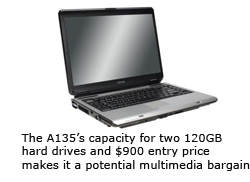For $900, Toshiba's Vista-loaded Satellite A135 hits right at the middle

Starting at $900, Toshiba's Satellite A135 (pictured left) is the low-cost entry amongst the company's Vista-loaded notebooks (but its price can scale up pretty quickly to $1499) and, like some of its siblings, it too sits on the fence between businesses and consumers. At least according to Toshiba's messaging (which could end up confusing the market). In its press release regarding the system, Toshiba says it offers "consumers a wide selection of feature-rich mobile computing solutions at an affordable price." Yet, in another e-mail that went to the press, Toshiba says the A135 is "designed for multimedia enthusiasts and road warriors."
| Photo Gallery: See the many angles and features of Toshiba's Satellite A135 (and Toshiba's three other Vista-preloaded notebooks) in our extensive image gallery. | ||
That e-mail went on to say that "Toshiba’s newest Satellite line—the Satellite A135 series—features a 15.4-inch diagonal widescreen display and has a starting weight of 6.0 pounds while featuring a DVD SuperMulti drive that reads and writes in up to 11 formats.." It sure started to sound like a low-cost mobile multimedia workhorse (of the sort that would appeal to consumers) until the same paragraph added "....as well as DDR2 memory for better performance of productivity applications." To be fair, consumers use productivity applications. But, if you've ever seen how most consumers use such applications, the notion that they'd need some sort of star peformer of a system to run them is just plain silly.
But if you want the smoking gun of how awkwardly positioned this system is between consumers and business, then its unique dual hard drive feature will not leave you disappointed. In one bit of company furnished language, Toshiba says:
The multimedia-rich Satellite A135-S4499 incorporates two 120GB serial ATA hard drives to provide consumers with the luxury of optimum storage capacity using both drives and the convenience of using one drive for business applications, while reserving the second hard drive for music, photos and other multimedia files. The Satellite A135-S4499 will be available for purchase on Feb. 20, 2007.
I laughed pretty hard when I read this. One drive for business apps (oops, there's that "business language" again) and the the other for music, photos, and other multimedia? About the only situation where this sort of architecure makes any sense is where that second drive has to be moved around between systems. Otherwise, I don't know many consumers who know or care about the physical location of the folders that hold their applications, pictures, videos, and other multimedia files.
About the only reason doing two drives makes sense is sheer capacity. Unlike with desktop drives which recently hit the 1 terabyte mark thanks to Hitachi (the previous record was set by IBM at 750GB), the bigger notebook drives run around 200GB. So, two 120GB drives get you to 240GB. Personally speaking, my sense is the other language that Toshiba offered for the A135 makes more sense (especially for businesses): "the Satellite A135-S4499 features a dual hard drive for optimal storage-capacity and secure data redundancy." Data redundancy has "business" written all over it.
Anyway, if you ask me, the somewhat non-descript in appearance Satellite A135 has "middle" (as in "right at the heart of the notebook market") written all over it, but with some good value. When you consider what's packed into the A135 for $900, it's a pretty good deal. For example, in response to my blog about Toshiba's Satellite U205 ultra-portable, one reader found a $898 AMD-based HP Pavilion notebook from Wal-Mart that he thought was a better deal. But it weighed more than a pound more than the U205 (putting it out of the ultra-portable class) and, at 5.4 pounds, competes much more head to head with the A135. And, based on the Pavilion's specs alone the A135 has some advantages. For example, a 15.4" display vs. the Pavilion's 14.1" display, a/b/g WiFi versus just b/g WiFi, and room for the second hard drive. I'm not saying it's a slam dunk. But you can see why I say the A135 strikes right at the heart of the notebook market.
Finally, here are the tops of the waves on the Satellite A135's specifications. Be sure to check out the A135's image gallery since I offer some additional text there.
- Processor: Intel Core 2 Duo Processor T5500, 1.66GHz, 2MB Level 2 cache, 667MHz front side bus
- Memory: 2048 MB PC4200 DDR2 SDRAM
- Graphics: Intel Graphics Media Accelerator 950
- Hard Drive: One or two 120 GB (4200 RPM) Serial-ATA (SATA) hard disk drive
- Optical: DVD SuperMulti ( +/-R double layer) drive supporting 11 formats (but not any HD formats)
- Display: 15.4 diagonal TFT active-matrix LCD display, 1280x800 native resolution (WXGA)
- Connectivity: Intel PRO/Wireless WiFi (802.11a/b/g), 10/100/1000-Base TX Ethernet (RJ-45), RJ-11 (POTS)
- Ports: 4 USB 2.0, 4 Pin unpowered Firewire
- Operating System: Windows Vista Ultimate 32-bit Version.
- Expansion: 1 5-in-1 Bridge Media Adapter (Secure Digital, Memory Stick, Memory Stick Pro, Multi Media Card, xD), 1 PC Card slot
- Weight: Starts at 6 pounds
- Price: Starts at $899
